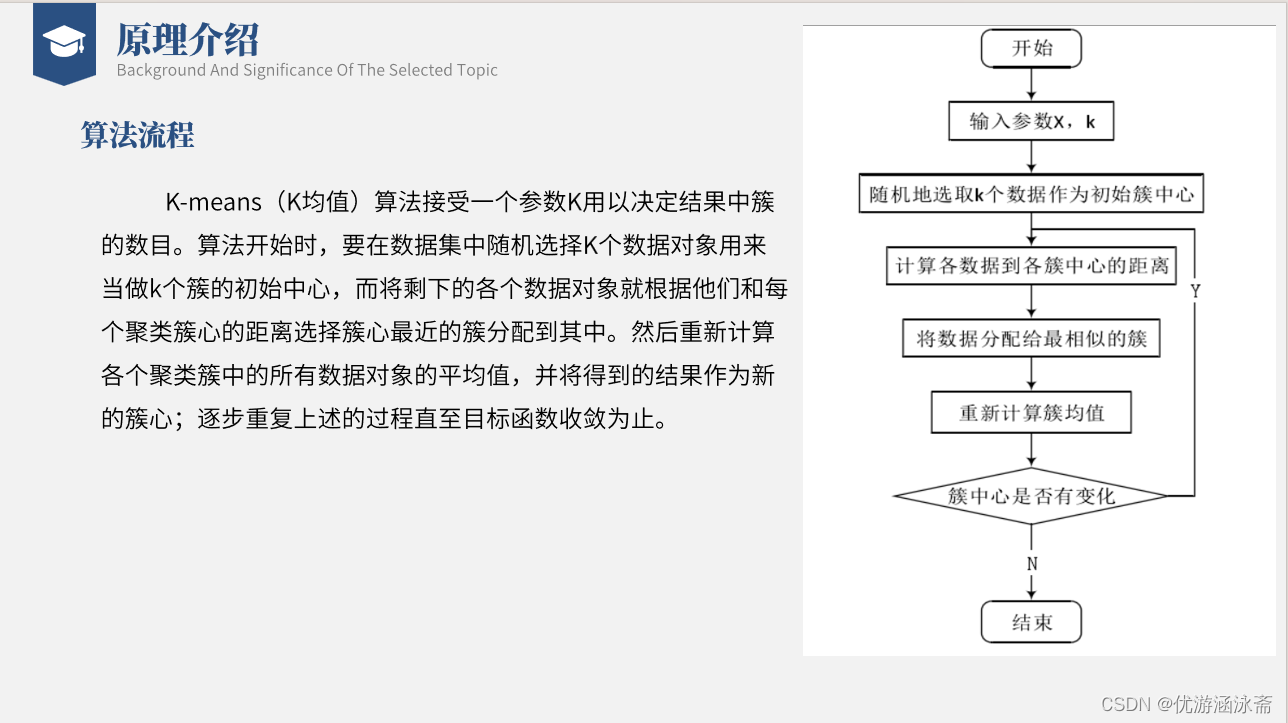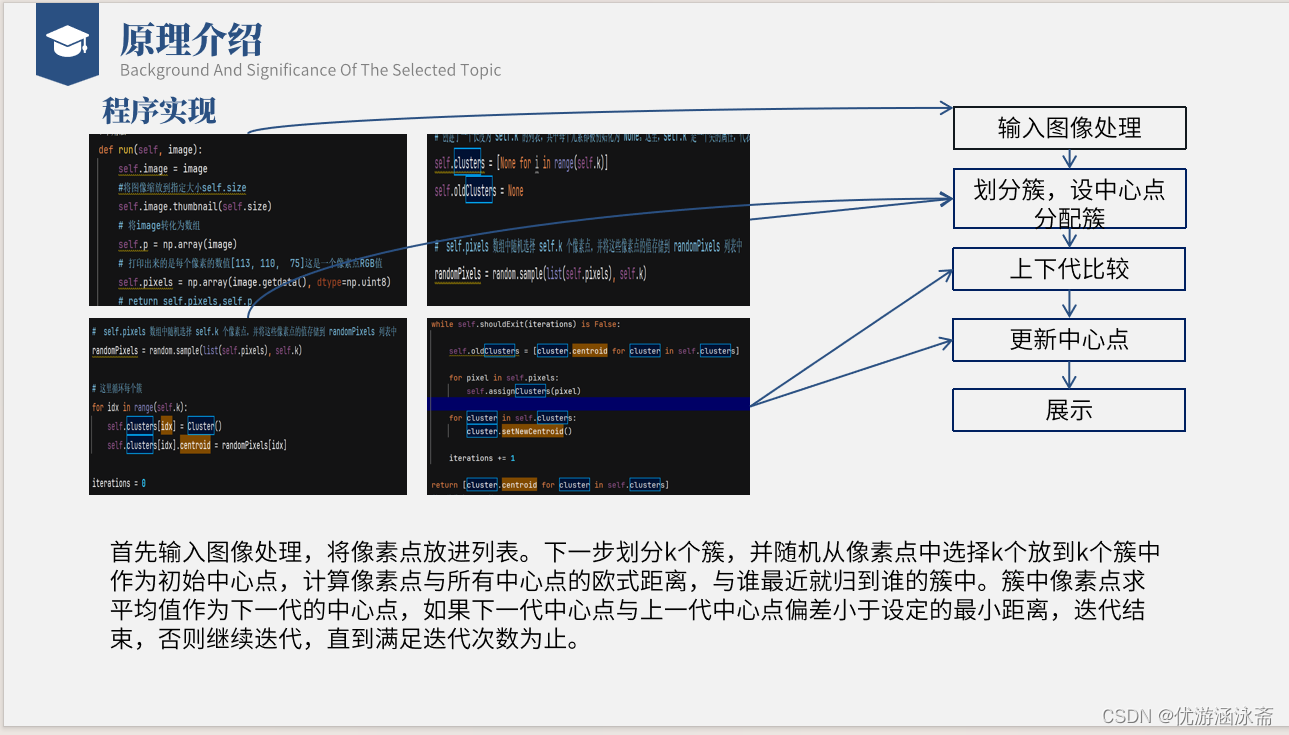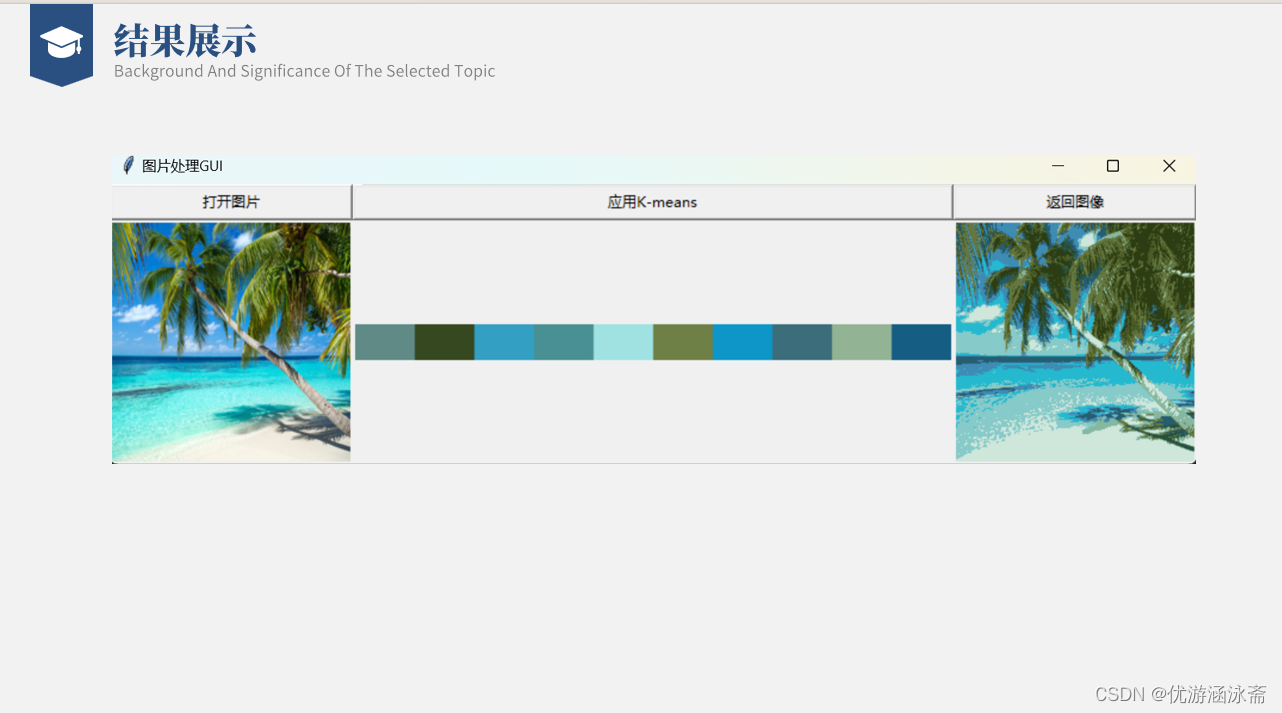代码
import tkinter as tk
from tkinter import filedialog
from PIL import Image, ImageTk
import numpy as np
import random
import math
class Cluster(object):
def __init__(self):
# pixels是像素的意思,这里定义一个像素组用来存放像素的值
self.pixels = []
# 创建一个中心点
self.centroid = None
def addPoint(self, pixels):
# 将像素值存放到这个空的pixels数组当中
self.pixels.append(pixels)
def setNewCentroid(self):
# 这里通道R在像素点中进行轮寻R就会得到一个数组,里面是所有像素点R通道的像素值
R = [colour[0] for colour in self.pixels]
G = [colour[1] for colour in self.pixels]
B = [colour[2] for colour in self.pixels]
# 求R,G,B所有像素点的平均值
R = sum(R) / len(R)
R= round(R)
G = sum(G) / len(G)
G = round(G)
B = sum(B) / len(B)
B = round(B)
self.centroid = (R,G,B)
return self.centroid
class Kmeans(object):
# 初始化k个簇,最大迭代次数,阈值用来判断中心点与上一代中心点的误差,小于就结束,图片大小
def __init__(self, k=10, max_iteration=10, min_distance=5.0, size=200):
self.k = k
self.max_iterations = max_iteration
self.min_distance = min_distance
self.size = (size, size)
def run(self, image):
self.image = image
#将图像缩放到指定大小self.size
self.image.thumbnail(self.size)
# 将image转化为数组
self.p = np.array(image)
# 打印出来的是每个像素的数值[113, 110, 75]这是一个像素点RGB值
self.pixels = np.array(image.getdata(), dtype=np.uint8)
# return self.pixels,self.p
# 创建了一个长度为 self.k 的列表,其中每个元素都被初始化为 None。这里,self.k 是一个类的属性,代表了你想要创建的簇(clusters)的数量。
self.clusters = [None for i in range(self.k)]
self.oldClusters = None
# self.pixels 数组中随机选择 self.k 个像素点,并将这些像素点的值存储到 randomPixels 列表中
randomPixels = random.sample(list(self.pixels), self.k)
# 这里循环每个簇
for idx in range(self.k):
self.clusters[idx] = Cluster()
self.clusters[idx].centroid = randomPixels[idx]
iterations = 0
while self.shouldExit(iterations) is False:
self.oldClusters = [cluster.centroid for cluster in self.clusters]
for pixel in self.pixels:
self.assignClusters(pixel)
for cluster in self.clusters:
cluster.setNewCentroid()
iterations += 1
return [cluster.centroid for cluster in self.clusters]
#分配簇,将像素分配到簇
def assignClusters(self, pixel):
# 可能是用来比较的shortest = float('Inf')这是设定距离为无穷大
shortest = float('Inf')
for cluster in self.clusters:
distance = self.calcDistance(cluster.centroid, pixel)
if distance < shortest:
shortest = distance
nearest = cluster
nearest.addPoint(pixel)
# 计算像素到中心点的欧式距离
def calcDistance(self, a, b):
# 计算欧氏距离
result = math.sqrt((a[0] - b[0]) ** 2 + (a[1] - b[1]) ** 2 + (a[2] - b[2]) ** 2)
# result = np.sqrt(sum((a-b) ** 2))
return result
# 迭代结束
def shouldExit(self, iterations):
if self.oldClusters is None:
return False
for idx in range(self.k):
dist = self.calcDistance(
np.array(self.clusters[idx].centroid),
np.array(self.oldClusters[idx])
)
if dist <self.min_distance:
return True
if iterations <= self.max_iterations:
return False
return True
# 显示原图像
def showImage(self):
self.image.show()
# 显示每个200*200的图像,颜色是每个聚类中心像素
def showCentroidColours(self):
# 创建cluster * 200大小的图像
total_width = len(self.clusters) * 200
# 整体高度是200
total_height = 200
big_image = Image.new("RGB", (total_width, total_height), "white")
# 计算每个小图片在大图上的位置
x_offset = 0
y_offset = 0
for cluster in self.clusters:
image = Image.new("RGB", (200, 200), cluster.centroid)
# 将小图片粘贴到大图上
big_image.paste(image, (x_offset, y_offset))
# 更新 x 偏移量以准备下一个图片的位置
x_offset += 200
# new_width = 1000
# new_height = 400
# new_image = Image.new('RGB', (new_width, new_height), 'white')
#
# big_image = np.array(big_image)
# image = np.concatenate((self.p, big_image), axis=0)
# image = np.vstack((image, big_image))
# big_image.show()
big_image = big_image.resize((500, 30))
return big_image
# y_offset = 0
# for img in zip([image, big_image]):
# new_image.paste(img, (0, y_offset))
# y_offset = y_offset + 1
# new_image.show()
# new_image.show()
# 颜色图像显示
def showClustering(self):
# 创建一个与localPixels相同长度的
localPixels =[None] * len(self.image.getdata())
for idx, pixel in enumerate(self.image.getdata()):
shortest = float('Inf')
for cluster in self.clusters:
distance =self.calcDistance(cluster.centroid, pixel)
if distance < shortest:
shortest = distance
nearest = cluster
localPixels[idx] = nearest.centroid
w,h = self.image.size
# 将localPixel转换为一个大小为(h, w, 3)的图像
localPixels = np.asarray(localPixels)\
.astype('uint8')\
.reshape((h, w, 3))
# 颜色图像显示
colourMap = Image.fromarray(localPixels)
colourMap = colourMap.resize((200, 200))
return colourMap
# colourMap.show()
# 初始化Tkinter窗口
root = tk.Tk()
root.title("图片处理GUI")
# 全局变量用于存储图片和图片数据
image_path = None
image_data = None
def open_image():
global image_path, image_data, image
# 打开文件对话框,选择图片文件
file_path = filedialog.askopenfilename(title="选择图片", filetypes=[("图像文件", "*.png;*.jpg;*.jpeg;*.bmp;*.gif")])
if file_path:
# 使用PIL打开图片
image = Image.open(file_path)
# 转换为Tkinter可以显示的格式
image = image.resize((200, 200))
tk_image = ImageTk.PhotoImage(image)
# 展示图片
label_image.config(image=tk_image)
label_image.config(padx=10, pady=5)
label_image.image = tk_image
# 存储图片路径和图片数据(转换为numpy数组)
image_path = file_path
image_data = np.array(image)
def apply_kmeans():
global image_data, image_path
if image_data is not None:
# 将图片数据重塑为二维数组,每行是一个像素,每列是RGB值
image = Image.open(image_path)
image = image.resize((200, 200))
# 初始化自定义的Kmeans类并运行算法
k = Kmeans()
# k.showImage()
k.run(image)
segmented_image_pil = k.showCentroidColours()
# 展示处理后的图片
segmented_tk_image = ImageTk.PhotoImage(segmented_image_pil)
label_segmented.config(image=segmented_tk_image)
label_segmented.image = segmented_tk_image
else:
print("请先打开一张图片!")
# 创建按钮来打开图片
def apply_kmeans1():
global image_data, image_path
if image_data is not None:
# 将图片数据重塑为二维数组,每行是一个像素,每列是RGB值
image = Image.open(image_path)
image = image.resize((200, 200))
# 初始化自定义的Kmeans类并运行算法
k = Kmeans()
# k.showImage()
k.run(image)
segmented_image_pil = k.showClustering()
# 展示处理后的图片
segmented_tk_image = ImageTk.PhotoImage(segmented_image_pil)
label_segmented1.config(image=segmented_tk_image)
label_segmented1.image = segmented_tk_image
else:
print("请先打开一张图片!")
# 创建按钮来打开图片
button_open = tk.Button(root, text="打开图片", command=open_image)
# 使用 grid 布局,并指定在第0行第0列
button_open.grid(row=0, column=0, sticky="ew")
# 创建标签来展示原始图片
label_image = tk.Label(root)
# sticky="news" 表示填充所有方向
label_image.grid(row=1, column=0, sticky="news")
# 创建按钮来应用K-means算法
button_kmeans = tk.Button(root, text="应用K-means", command=apply_kmeans)
button_kmeans.grid(row=0, column=1, sticky="ew")
# 创建标签来展示K-means处理后的图片
label_segmented = tk.Label(root)
label_segmented.grid(row=1, column=1, sticky="news")
button_kmeans1 = tk.Button(root, text="返回图像", command=apply_kmeans1)
button_kmeans1.grid(row=0, column=2, sticky="ew")
label_segmented1 = tk.Label(root)
label_segmented1.grid(row=1, column=2, sticky="news")
# 运行Tkinter事件循环
root.columnconfigure(0, weight=1)
root.columnconfigure(1, weight=1)
root.columnconfigure(2, weight=1)
root.mainloop()



